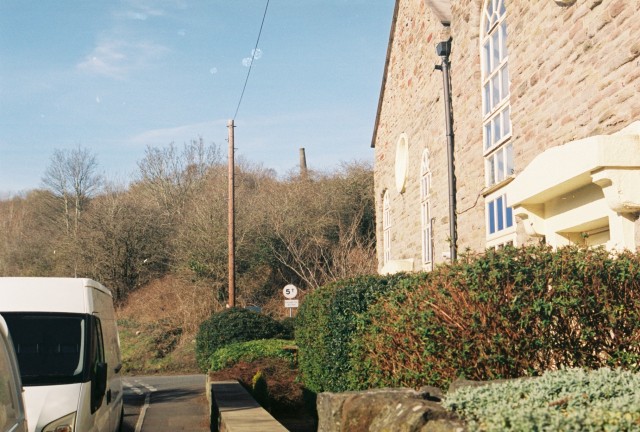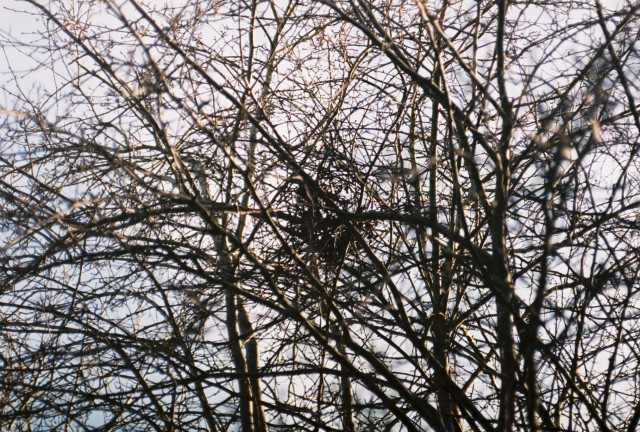Photographs from southwest end of Trooper’s Hill Road, Bristol
Notes made in Trooper’s Hill nature reserve
Friday PM 25/03/2016
So. It’s been a while. What started as a simple conceit — walk locally, play with my camera, read some Ansel Adams — has taken on a trickier hue than it ever should have done. What happened? I started driving to work instead of getting the bus, so no meanders down the hill. The evenings drew in. A cloud descended whereby effort — and a project — felt futile. I contracted whooping-cough — I’m about halfway through this 100-day cough. And then there’s Ansel Adams himself. As a figure, I’m sure he loomed large; but more than that, he has a penchant for the monumental within the landscape.
The first photograph in the book is Monolith, the Face of Half Dome, Yosemite, a massive extrusion of rock rising from the snowy alpine slopes around, which sets the scene for the rest of the book. Even his detail shots have a sort grandness, an expansiveness that seems to circumvent the closeness of the shot. His technical language too: on page three, a section is headed Most exposure failures result from erroneous meter readings. I don’t own a photometer, and doubt I could even find one of his recommendations: “The Gamma Scientific, Inc., Luminance Analyzer a-500 measures with great accuracy a solid angle of ½º”. Ok. So do I need one? Is there an inbuilt function for my fairly modern Nikon SLR?
I wanted his overall philosophy to inspire and inform my own attempts at photography, but instead I get the sensation of reading a rather dry technical manual (and who reads technical manuals?).

Approaching Trooper’s Hill. The chimney atop is a landmark hereabout (though not the focus of this post).
But today, I got out. There were two features I wanted to focus on, at the bottom of Trooper’s Hill Road. 1: The half-ruined chimney stack that forms the corner piece of the Trooper’s Hill nature reserve. 2: The peculiar ripples in the tarmacadam on a steep section of the road
* * *
The chimney stack felt like an important feature — one that gels with Adams’s penchant for the monumental. It’s tall and narrow, and seemingly once the corner of a larger building. Like Adams’s Half Dome, it apparently speaks of endeavour greater than the photographers’ practical ken. And it’s visible, but rarely properly seen — though perhaps this is an inference too far.
Trooper’s Hill’s appearance is due to extensive quarrying and mining, for Pennant Sandstone, coal and fireclay. The coal was used for smelting copper ore which was brought here via the nearby River Avon. An information board informs that in 1754 there were 49 copper smelting furnaces in the Crew’s Hole area. This particular chimney, though, formed part of an engine house, that was used for hauling up coal and pumping out water from mines.
* * *
The ripples are a more beguiling — and less monumental — feature. I don’t know what’s caused them, but I’ve seen something similar in two different (though mechanically similar) situations. My first thought was toward storm water charging down the hill during heavy rain. Like the rippled bed of a stream, the tarmac itself taking on the form of the rippling water, but held in time — like a photo of a stream; the landscape’s own attempt to make permanent that which is ephemeral.
But what if something more machine-like has caused this? I think of mountain biking. It can be seen on popular trails where a fast straight approaches a slower technical section. As riders approach the corner, they are prone to braking heavily. The wheels tend to skip and skitter where recesses form: known (unimaginatively) as braking bumps.
I’m not sure if either parallel explains the ripples in the road — they’re on the uphill side of the road, so maybe they’re caused by acceleration in a similar manner to braking bumps. But then, the hill’s steep, so perhaps the rain has enough force to do this. Maybe it’s shoddy workmanship. Maybe a combination, or none of this.
But at least I’ve made an effort to record both the bumps and the chimney. Isn’t that why I began this project?
POSTSCRIPT
Notes from Easter Sunday, 27/03/2016
“Isn’t that why I began this project?” Well, yes, that was certainly an intended aim. But it was also to get more from my camera. I look back on the processed photos, and I’m not happy with them. Too out-of-focus, poor colour contrast, lost detail. Ansel Adams recommends use of a light meter, and after these photos, I can see how it would help. His discussion of sources of light and how best to use them could be focussed on more closely. I would also probably benefit from paying more attention to my camera, such as noting settings. I struggled to match the better photographs with the settings used.
And last, I already had a plan before I set out of what I wished to capture; though perhaps I should be more flexible. When I got out, a couple more things caught my eye. The rotting wood in the verge, birds in flight. And last: a half-finished nest in the bare May tree. Or was it crown of thorns?

Ring of twigs in the May tree.












